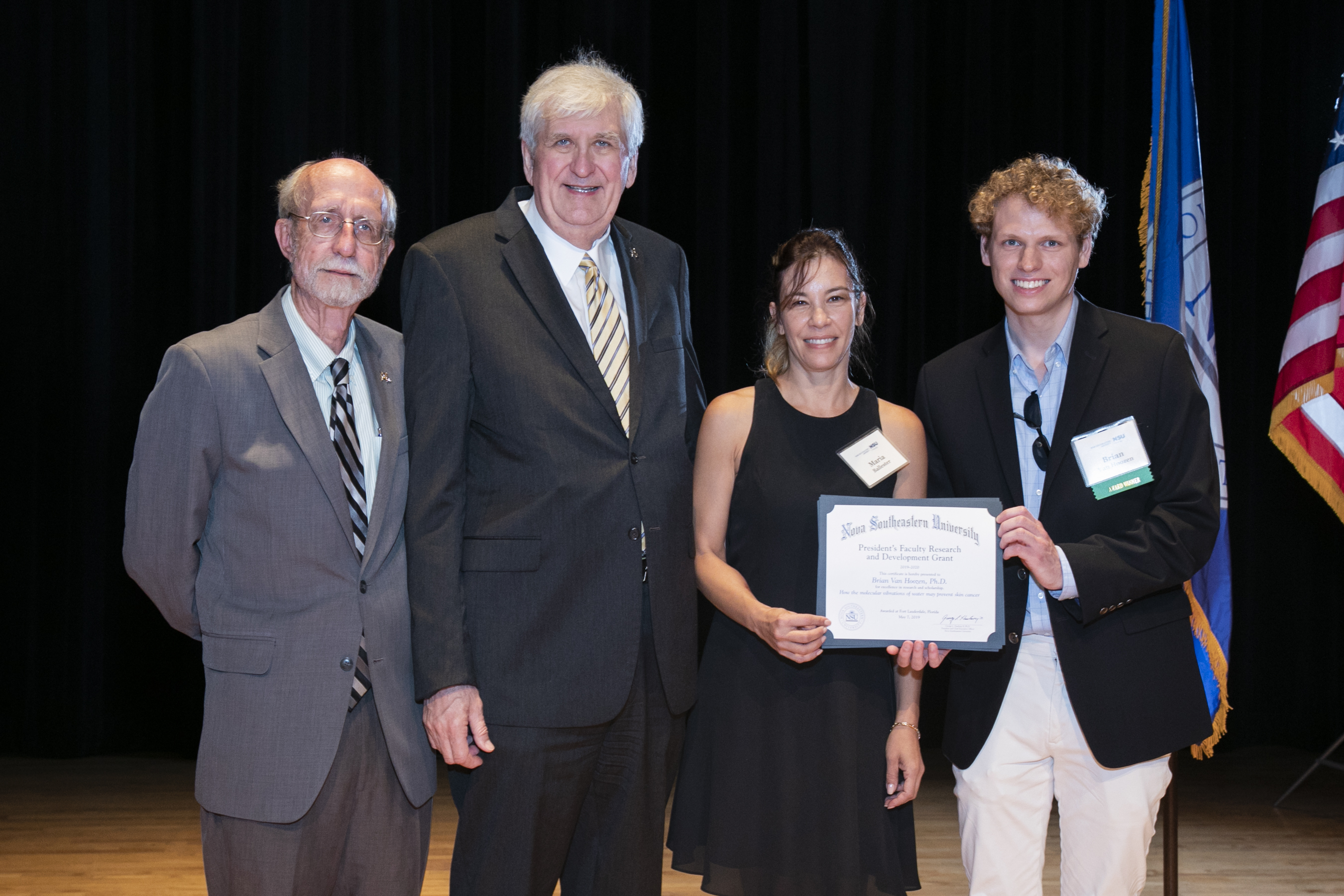How the molecular vibrations of water may prevent skin cancer
Grant Winners
- Brian Van Hoozen, Ph.D. – Halmos College of Oceanography and Natural Sciences
- Maria Ballester, Ph.D. – Halmos College of Oceanography and Natural Sciences
- Ariana Sarkhail – Halmos College of Oceanography and Natural Sciences
- Cassidy Loucks – Halmos College of Oceanography and Natural Sciences
Dean
- Richard Dodge, Ph.D. – Halmos College of Oceanography and Natural Sciences
Abstract

Skin cancer is by far the most common cancer worldwide. It has been well established that exposure to ultraviolet light (usually from the sun or tanning beds) significantly increases the likelihood of being diagnosed with skin cancer. Studies have shown that when DNA absorbs ultraviolet light it can become structurally damaged leading to a mutation and possibly cancer. However, exactly how this happens is not well understood. Furthermore, exposing skin to sunlight usually does not lead to a mutation. This indicates that after the ultraviolet light is absorbed by the DNA the energy from the light can either cause a structural change to the DNA (a mutation) or be dissipated some other way that does not damage the DNA. Why DNA is damaged in some cases but not in others is not well understood. Studies have shown that absorption of ultraviolet light causes molecular vibrations in DNA. It is likely that these vibrations sometimes cause structural changes to the DNA. It has also been proposed that structural damage to the DNA is avoided when the vibrations of the DNA couple with the vibrations of the nearby water molecules. This coupling would cause the vibrations to be transferred to the water molecules which would avoid structural damage to the DNA. Thus, understanding how DNA vibrates and the role the solvent plays in those vibrations is crucial to understanding how DNA interacts with ultraviolet light. The study we are proposing will use quantum mechanical calculations and infrared spectroscopy to understand under what circumstances the vibrations of a model systems for DNA can transfer to solvent molecules. This is important for understanding a mechanism by which skin cancer can be avoided. This work will lead to one or more publications and proposals for extramural funding of future studies of vibrations transferring from DNA base pairs to nearby water molecules.
 Skin cancer is by far the most common cancer worldwide. It has been well established that exposure to ultraviolet light (usually from the sun or tanning beds) significantly increases the likelihood of being diagnosed with skin cancer. Studies have shown that when DNA absorbs ultraviolet light it can become structurally damaged leading to a mutation and possibly cancer. However, exactly how this happens is not well understood. Furthermore, exposing skin to sunlight usually does not lead to a mutation. This indicates that after the ultraviolet light is absorbed by the DNA the energy from the light can either cause a structural change to the DNA (a mutation) or be dissipated some other way that does not damage the DNA. Why DNA is damaged in some cases but not in others is not well understood. Studies have shown that absorption of ultraviolet light causes molecular vibrations in DNA. It is likely that these vibrations sometimes cause structural changes to the DNA. It has also been proposed that structural damage to the DNA is avoided when the vibrations of the DNA couple with the vibrations of the nearby water molecules. This coupling would cause the vibrations to be transferred to the water molecules which would avoid structural damage to the DNA. Thus, understanding how DNA vibrates and the role the solvent plays in those vibrations is crucial to understanding how DNA interacts with ultraviolet light. The study we are proposing will use quantum mechanical calculations and infrared spectroscopy to understand under what circumstances the vibrations of a model systems for DNA can transfer to solvent molecules. This is important for understanding a mechanism by which skin cancer can be avoided. This work will lead to one or more publications and proposals for extramural funding of future studies of vibrations transferring from DNA base pairs to nearby water molecules.
Skin cancer is by far the most common cancer worldwide. It has been well established that exposure to ultraviolet light (usually from the sun or tanning beds) significantly increases the likelihood of being diagnosed with skin cancer. Studies have shown that when DNA absorbs ultraviolet light it can become structurally damaged leading to a mutation and possibly cancer. However, exactly how this happens is not well understood. Furthermore, exposing skin to sunlight usually does not lead to a mutation. This indicates that after the ultraviolet light is absorbed by the DNA the energy from the light can either cause a structural change to the DNA (a mutation) or be dissipated some other way that does not damage the DNA. Why DNA is damaged in some cases but not in others is not well understood. Studies have shown that absorption of ultraviolet light causes molecular vibrations in DNA. It is likely that these vibrations sometimes cause structural changes to the DNA. It has also been proposed that structural damage to the DNA is avoided when the vibrations of the DNA couple with the vibrations of the nearby water molecules. This coupling would cause the vibrations to be transferred to the water molecules which would avoid structural damage to the DNA. Thus, understanding how DNA vibrates and the role the solvent plays in those vibrations is crucial to understanding how DNA interacts with ultraviolet light. The study we are proposing will use quantum mechanical calculations and infrared spectroscopy to understand under what circumstances the vibrations of a model systems for DNA can transfer to solvent molecules. This is important for understanding a mechanism by which skin cancer can be avoided. This work will lead to one or more publications and proposals for extramural funding of future studies of vibrations transferring from DNA base pairs to nearby water molecules.